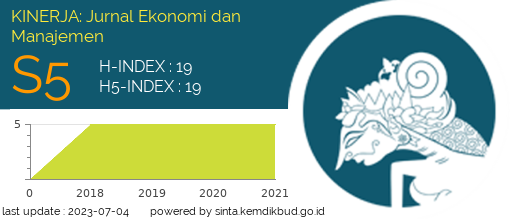Hubungan antara restaurant image, perceived value, customer satisfaction, dan behavioral intention
Abstract
Tujuan dari penelitian ini adalah untuk menjelaskan hubungan antara restaurant image, perceived value, customer satisfaction, dan behavioral intention pada casual dining restaurant di Kota Surabaya Jumlah sampel pada penelitian ini adalah sebanyak 200 responden yang dibagikan kepada konsumen yang pernah mengunjungi salah satu casual dining restaurant di Kota Surabaya. Penelitian ini menggunakan teknik purposive sampling dengan kriteria sebagai berikut: (1) pernah makan di salah satu casual dining restaurant di Kota Surabaya; dan (2) telah berusia minimal 17 tahun. Teknik analisis data dilakukan dengan menggunakan Partial Least Square (PLS) dengan SmartPLS 2.0. Hasil penelitian ini menunjukkan bahwa: (1) restaurant image secara signifikan memengaruhi perceived value; (2) restaurant image dan perceived value memiliki peran penitng dalam memengaruhi customer satisfaction; (3) hasil penelitian ini juga menunjukkan bahwa customer satisfaction memediasi secara signifikan hubungan antara restaurant image, perceived value dan behavioral intention.
Keywords
Full Text:
PDF (Bahasa Indonesia)References
Canny, I. U., (2014). Measuring The Mediating Role of Dining Experience Attributes on Customer Satisfaction and Its Impact on Behavioral Intentions Of Casual Dining Restaurant in Jakarta. International Journal of Innovation, Management and Technology, Vol. 5, No. 1, February 2014.
Chiou, J.S. (2004). The antecedents of consumers’ loyalty toward internet service providers. Information and Management, Vol. 41 No. 6, pp. 685-95.
Engel. James.F.Roger. D.Black Well And Paul.W.Miniard. (1995).,Perilaku Konsumen.Jakarta.Bina Rupa Aksara.Hal. 3.
Gerson, Richard. F. (2004).Mengukur Kepuasan Pelanggan, PPM, Jakarta.
Ghozali, Imam. (2011). “Aplikasi Analisis Multivariate Dengan Program SPSS”. Semarang: Badan Penerbit Universitas Diponegoro.
Griffin, Jill. (2003). Customer Loyalty : Menumbuhkan Dan Mempertahankan Pelanggan. Jakarta, Airlangga
Ha, J., Jang, S.S. (2010). Effects of service quality and food quality: the moderating role of atmospherics in an ethnic restaurant segment. International Journal of Hospitality Management, Vol.29, No.3, pp 520–529.
Han, H. and Ryu, K. (2009). The roles of the physical environment, price perception, and customer satisfaction in determining customer loyalty in the restaurant industry. Journal of Hospitality and Tourism Research. Vol. 33 No. 4, pp. 487-51
Hsu, M. K., Huang, Y., and Swanson, S. (2009). Grocery store image, travel distance, satisfaction and behavioral intentions: Evidence from a Midwest college town. International Journal of Retail & Distribution Management, Vol. 38, pp.115-32.
Hutama, Christanto Leoma dan Hartono Subagio. (2014). Analisa pengaruh dining experience terhadap behavioral intention dengan customer satisfaction sebagai variabel intervening (studi kasus : domicile kitchen and lounge). Jurnal Manajemen Pemasaran Petra, vol. 2, no. 1
Jeoung, EunHa and SooCheong Jang. (2011). Restaurant experiences triggering positive electronic word-of-mouth (eWOM) Motivations. International Journal of Hospitality Management, vol. 30, pp. 356–366.
Jung, Jae Man, Sandra Sydnor, Seul Ki Lee, and Barbara Almanza. (2015). A conflict of choice: How consumers choose where to go for dinner. International Journal of Hospitality Management, Vol. 45, pp. 88–98
Kim, W.G., Ng, C.Y.N. and Kim, Y.S. (2009). Influence of international DINESERV on customer satisfaction, return intention, and word-of-mouth. International Journal of Hospitality Management. Vol. 28 No. 1, pp. 10-17.
Kivela, J., Inbakaran, R. and Reece, J. (1999). Consumer research in the restaurant environment, part 1: A conceptual model of dining satisfaction and return patronage. International Journal of Contemporary Hospitality Management, vol. 11, No. 5, pp. 205-222.
Kivela, J., Inbakaran, R., Reece, J., (2000). Consumer research in the restaurant environment. Part 3: analysis, findings and conclusions. International Journal of Contemporary Hospitality Management. Vol.12, No.1, pp.13–30.
Kotler Philip, and Gary Amstrong. (2012). Principles Of Marketing.14 th Edition. New Jersey: Pearson Education, Inc.
Kotler, Philip. (2010). Manajemen Pemasaran, Edisi Milenimun, Benyamin Molan (Terjemahan), Prehalindo, Jakarta.
Lai, F., Griffin, M. and Babin, B.J. (2009). How quality, value, image, and satisfaction create loyalty at a Chinese telecom, Journal of Business Research, Vol. 62 No. 10, pp. 980-6.
Namkung, Y., & Jang, S. (2008). Does food quality really matter in restaurants? Its impact on customer satisfaction and behavioral intentions. Journal of Hospitality and Tourism Research, Vol. 31, No.3, pp. 387-409.
Oliver, Richard L., 1999, “Whence Consumer Loyalty”, Journal of Marketing., Volume 63 Special Issue, pp. 33-44.
Riordan, Christine, Robert. D. Gatewood and Jodi Barnes Bill. (1997). Corporote Image: Employee Reaction and Implications for Managing Corporate Social Performance. Journal of Business Ethics, Vol. 16, pp. 401-412.
Robert Bacal. (2005). Performance Management. Dalam Sarwoto. 1983(Ed.), Definisi Motivasi. Jakarta: GM
Ruslan, Rosady. (1994). Praktik dan Solusi Public Relations dalam Situasi Krisis dan Pemulihan Citra, Jakarta: Ghalia Indonesia.
Ryu, K. and Han, H. (2010). Influence of the quality of food, service, and physical environment on customer satisfaction in quick-casual restaurants: moderating role of perceived price. Journal of Hospitality & Tourism Research, Vol. 34 No. 3, pp. 310-29.
Ryu, Kisang, Heesup Han, and Tae-Hee Kim. (2008). The relationships among overall quick-casual restaurant image, perceived value, customer satisfaction, and behavioral intentions. International Journal of Hospitality Management, Vol. 27, pp. 459–469
Ryu, Kisang, Hye-Rin Lee, and Woo Gon Kim. (2012). The influence of the quality of the physical environment, food, and service on restaurant image, customer perceived value, customer satisfaction, and behavioral intentions. International Journal of Contemporary Hospitality Management, Vol. 24, No. 2, pp. 200-223.
Solomon, R. Michael. (2002). Consumer Behavior, Buying, Having, and Being. 8th. Edition. New Jersey: Prentice Hall.
Tang, W. (2007). Impact of Corporate image and Corporate Reputation on Customer Loyalty: A Review. Management Science and Engineering. 1(2): 57-62.
Tjiptono, Fandy. (2008). Pemasaran Strategik. Penerbit Andi. Yogyakarta.
Yang, Z. dan Peterson, R.T., (2004), “Customer Perceived Value, Satisfaction, and Loyalty: The Role of Switching Costs”, Psychology & Marketing Journal, Vol. 21(10), October, p.99–822.
Zeithaml, Valarie A. and Bitner, Mary Jo. (2003). Service Marketing. McGraw Hill Inc, Int’l Edition, New York.
DOI: https://doi.org/10.30872/jkin.v15i2.3743
Refbacks
- There are currently no refbacks.
Copyright (c) 2018 Larasati Ayu Sekarsari
Kinerja: Jurnal Ekonomi dan Manajemen
Faculty of Economics and Business, Mulawarman University
Jl. Tanah Grogot No.1 Samarinda Kalimantan Timur 75119
Email: jkin.feb.unmul@gmail.com
StatCounter: Kinerja


